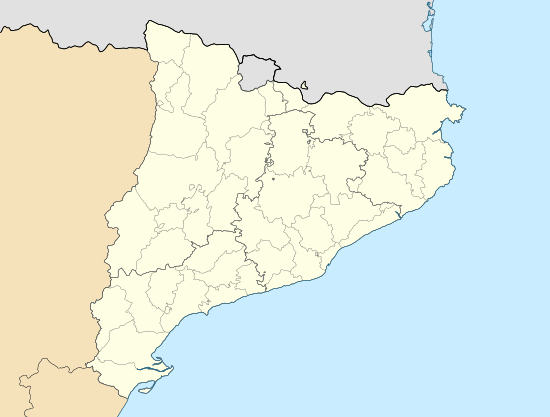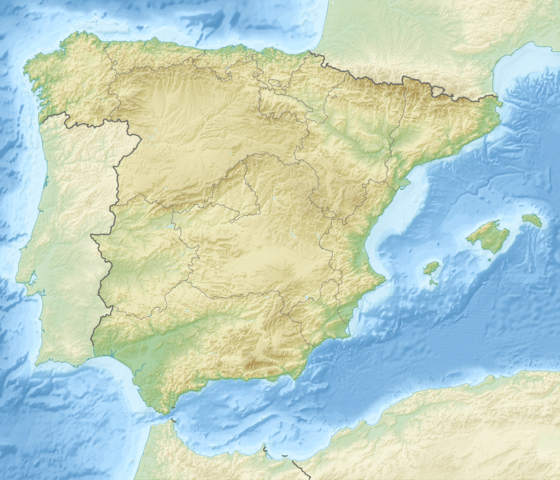Roca dels Moros
| UNESCO World Heritage site | |
|---|---|
|
The Dance of Cogul. Tracing by Henri Breuil. | |
| Location | El Cogul, Garrigues, Province of Lleida, Catalonia, Spain |
| Part of | Rock Art of the Mediterranean Basin on the Iberian Peninsula |
| Criteria | Cultural: (iii) |
| Reference | 874-021 |
| Inscription | 1998 (22nd Session) |
| Coordinates | 41°28′0.6″N 0°41′51.5″E / 41.466833°N 0.697639°ECoordinates: 41°28′0.6″N 0°41′51.5″E / 41.466833°N 0.697639°E |
 Location of Roca dels Moros in Catalonia  Roca dels Moros (Spain) | |
The Roca dels Moros or Caves of El Cogul is a rock shelter containing paintings of prehistoric Levantine rock art. The site is in El Cogul, in the autonomous community of Catalonia, Spain. Since 1998 the paintings have been protected as part of the Rock art of the Iberian Mediterranean Basin, a UNESCO World Heritage Site. Inscriptions in Northeastern Iberian script and in Latin alphabet indicate that the place was used as a sanctuary into Iberian and Roman times.
Location, discovery
The Caves of El Cogul are a rock shelter in El Cogul in the autonomous community of Catalonia, Spain. In 1908 paintings of prehistoric Levantine rock art were discovered by the village rector, Ramon Huguet, and a report was published in the same year.[1] The first prehistorians to study the paintings, such as Henri Breuil and Juan Cabré, took the view that Levantine rock art belonged to the palaeolithic. There is now a consensus that the paintings are post-palaeolithic, although uncertainty persists as to their date. Since 1998 the paintings have been protected as part of a UNESCO World Heritage Site (reference 874).[2] Near the paintings is a cemetery with tombs carved into the rock. Inscriptions in Northeastern Iberian script and in Latin alphabet, one of which is an ex-voto, indicate that the use of the caves as a sanctuary extended to Iberian and Roman times.
The dancers of Cogul
At Roca dels Moros there are forty-five figures depicted, of which thirty-eight are painted bright red, black and dark red, seven are engraved in stone. A dance scene is the most famous of the paintings: Nine women are depicted, something new in Spanish art. Some are painted in black and others in red. They dance around a small male figure at the center with an abnormally large phallus. Along with humans, there are several animals.
 External view of the actual rock shelter
External view of the actual rock shelter Detail of the paintings
Detail of the paintings Detail of the paintings
Detail of the paintings
Conservation
Conservation work has been carried out on the paintings under the auspices of the Museu d'Arqueologia de Catalunya. Plans exist to build a visitors centre to interpret the site and to promote Cogul in the context of a "route of rock art", linking it to similar sites in Catalonia such as Abrics de l’Ermita at Ulldecona.[3]
References
- ↑ Las pinturas rupestres de Cogul, Ceferí Rocafort, Boletín del Centro Excursionista de Cataluña (Bulletin of the Field Club of Catalonia), 1908
- ↑ Rock Art of the Iberian Mediterranean Basin, UNESCO
- ↑ (in Catalan) (in Spanish) Interpretation Centre of the Roca dels Moros (cogul.rupestre.org)
Bibliography
- (in Catalan) Volume I of the Història de Catalunya directed by Pierre Vilar: Prehistòria i història antiga, Joan Maluquer de Motes.
- (in Catalan) Anna Alonso Tejada, Alexandre Grimal Navarro (2007): L´Art Rupestre del Cogul. Primeres Imatges Humanes a Catalunya, Pagès Editors, Lleida, ISBN 978-84-9779-593-7.
- Alexandre GRIMAL, Anna ALONSO (2007): Catálogo de Cataluña, Cuenca, Albacete, Guadalajara y Andalucía ("Catalogue of Catalonia, Cuenca, Albacete, Guadalajara and Andalucia") from Catálogo del Arte Rupestre Prehistórico de la Península Ibérica y de la España Insular. Arte Levantino ("Catalogue of prehistoric rock art of the Iberian Peninsula and the Spanish Islands. Levantine Art"), Real Academia de Cultura Valenciana, Archaeological Series, nº 22, Valencia, I-II Vols, pp. 113–252 (Vol I), pp. 41–85 (Vol II). ISBN 978-84-96068-84-1.
- (in Catalan) Anna ALONSO TEJADA, Alexandre GRIMAL (2003): L´art rupestre prehistòric a la comarca de les Garrigues, III Trobada d´Estudiosos de la Comarca de les Garrigues, Ajuntament de Cervià de les Garrigues (Lleida), pp. 17–25.
External links
- (in Catalan) Les pintures i grabats del Cogul, Archaeology Museum of Catalonia - Catalan Institute of Human Paleoecology and Social Evolution
- Department of Culture of the Generalitat of Catalonia